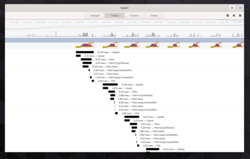Profiling & optimizing GNOME Software
Over the past few months, the Endless OS Foundation has been putting focus on improving GNOME Software’s reliability and performance. Endless OS is an OSTree-based immutable OS, and applications are entirely distributed as Flatpaks. GNOME Software is the frontend to that, and since our target userbase is definitely not going to use a terminal, we need to make sure GNOME Software delivers a good experience.
This focus has been materializing with Philip’s long effort to switch GNOME Software to a different threading model, more suitable to what Software does these days; and more recently, I’ve been tasked to look at GNOME Software’s performance from a profiling perspective.
Update by Rianne Schestowitz
-
Endless OS 5 Release Adds Wayland Support With GNOME 41
Endless OS is an app-centric operating system that pitches itself as an intuitive smartphone-like experience on a desktop.
The last major release came back in November 2021 as Endless OS 4.
Since then, the co-founder of elementary OS, Cassidy James, has joined the Endless OS Foundation as a 'Partner Success Engineer'.
Update by Rianne Schestowitz
-
Endless OS 5.0: Another Linux Distro Betting on Immutability
Endless OS is a Debian-based, fully desktop-oriented Linux operating system. Despite its strong desktop focus, it only occasionally falls under the radar, unlike other niche-leading distros such as Linux Mint, Fedora, Manjaro, and so on, because the approach is quite different here. So, let’s first clarify for readers what this is all about.
Endless OS features a custom desktop environment as the OS is designed to provide offline access to information and educational content. To achieve this, it comes preinstalled with various apps and tools for productivity and entertainment. Moreover, it gives access to an extensive library of educational content without needing an internet connection.

